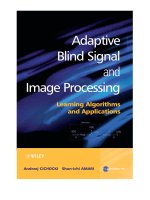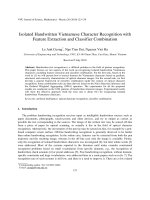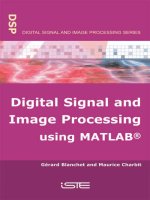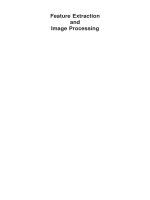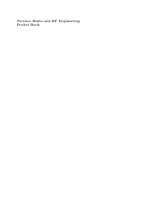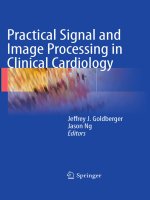nixon, m. s. (2002) feature extraction and image processing
Bạn đang xem bản rút gọn của tài liệu. Xem và tải ngay bản đầy đủ của tài liệu tại đây (4.2 MB, 360 trang )
Feature Extraction
and
Image Processing
Dedication
We would like to dedicate this book to our parents. To Gloria and to
Joaquin Aguado, and to Brenda and the late Ian Nixon.
Feature Extraction
and
Image Processing
Mark S. Nixon
Alberto S. Aguado
Newnes
OXFORD AUCKLAND BOSTON JOHANNESBURG MELBOURNE NEW DELHI
Newnes
An imprint of Butterworth-Heinemann
Linacre House, Jordan Hill, Oxford OX2 8DP
225 Wildwood Avenue, Woburn, MA 01801-2041
A division of Reed Educational and Professional Publishing Ltd
A member of the Reed Elsevier plc group
First edition 2002
© Mark S. Nixon and Alberto S. Aguado 2002
All rights reserved. No part of this publication
may be reproduced in any material form (including
photocopying or storing in any medium by electronic
means and whether or not transiently or incidentally
to some other use of this publication) without the
written permission of the copyright holder except
in accordance with the provisions of the Copyright,
Designs and Patents Act 1988 or under the terms of a
licence issued by the Copyright Licensing Agency Ltd,
90 Tottenham Court Road, London, England W1P 0LP.
Applications for the copyright holder’s written permission
to reproduce any part of this publication should be addressed
to the publishers
British Library Cataloguing in Publication Data
A catalogue record for this book is available from the British Library
ISBN 0 7506 5078 8
Typeset at Replika Press Pvt Ltd, Delhi 110 040, India
Printed and bound in Great Britain
Preface ix
Why did we write this book? ix
The book and its support x
In gratitude xii
Final message xii
1 Introduction 1
1.1 Overview 1
1.2 Human and computer vision 1
1.3 The human vision system 3
1.4 Computer vision systems 10
1.5 Mathematical systems 15
1.6 Associated literature 24
1.7 References 28
2 Images, sampling and frequency domain
processing 31
2.1 Overview 31
2.2 Image formation 31
2.3 The Fourier transform 35
2.4 The sampling criterion 40
2.5 The discrete Fourier transform ( DFT) 45
2.6 Other properties of the Fourier transform 53
2.7 Transforms other than Fourier 57
2.8 Applications using frequency domain properties 63
2.9 Further reading 65
2.10 References 65
3 Basic image processing operations 67
3.1 Overview 67
3.2 Histograms 67
3.3 Point operators 69
3.4 Group operations 79
3.5 Other statistical operators 88
3.6 Further reading 95
3.7 References 96
4 Low- level feature extraction ( including edge
detection) 99
4.1 Overview 99
4.2 First-order edge detection operators 99
4.3 Second- order edge detection operators 120
4.4 Other edge detection operators 127
4.5 Comparison of edge detection operators 129
4.6 Detecting image curvature 130
4.7 Describing image motion 145
4.8 Further reading 156
4.9 References 157
5 Feature extraction by shape matching 161
5.1 Overview 161
5.2 Thresholding and subtraction 162
5.3 Template matching 164
5.4 Hough transform (HT) 173
5.5 Generalised Hough transform (GHT) 199
5.6 Other extensions to the HT 213
5.7 Further reading 214
5.8 References 214
6 Flexible shape extraction ( snakes and other
techniques) 217
6.1 Overview 217
6.2 Deformable templates 218
6.3 Active contours (snakes) 220
6.4 Discrete symmetry operator 236
6.5 Flexible shape models 240
6.6 Further reading 243
6.7 References 243
7 Object description 247
7.1 Overview 247
7.2 Boundary descriptions 248
7.3 Region descriptors 278
7.4 Further reading 288
7.5 References 288
8 Introduction to texture description,
segmentation and classification 291
8.1 Overview 291
8.2 What is texture? 292
8.3 Texture description 294
8.4 Classification 301
8.5 Segmentation 306
8.6 Further reading 307
8.7 References 308
Appendices 311
9.1 Appendix 1: Homogeneous co-ordinate system 311
9.2 Appendix 2: Least squares analysis 314
9.3 Appendix 3: Example Mathcad worksheet for
Chapter 3 317
9.4 Appendix 4: Abbreviated Matlab worksheet 336
Index 345
Preface
Why did we write this book?
We will no doubt be asked many times: why on earth write a new book on computer vision?
Fair question: there are already many good books on computer vision already out in the
bookshops, as you will find referenced later, so why add to them? Part of the answer is that
any textbook is a snapshot of material that exists prior to it. Computer vision, the art of
processing images stored within a computer, has seen a considerable amount of research by
highly qualified people and the volume of research would appear to have increased in
recent years. That means a lot of new techniques have been developed, and many of the
more recent approaches have yet to migrate to textbooks.
But it is not just the new research: part of the speedy advance in computer vision
technique has left some areas covered only in scant detail. By the nature of research, one
cannot publish material on technique that is seen more to fill historical gaps, rather than to
advance knowledge. This is again where a new text can contribute.
Finally, the technology itself continues to advance. This means that there is new hardware,
new programming languages and new programming environments. In particular for computer
vision, the advance of technology means that computing power and memory are now
relatively cheap. It is certainly considerably cheaper than when computer vision was starting
as a research field. One of the authors here notes that the laptop that his portion of the book
was written on has more memory, is faster, has bigger disk space and better graphics than
the computer that served the entire university of his student days. And he is not that old!
One of the more advantageous recent changes brought by progress has been the development
of mathematical programming systems. These allow us to concentrate on mathematical
technique itself, rather than on implementation detail. There are several sophisticated
flavours of which Mathcad and Matlab, the chosen vehicles here, are amongst the most
popular. We have been using these techniques in research and in teaching and we would
argue that they have been of considerable benefit there. In research, they help us to develop
technique faster and to evaluate its final implementation. For teaching, the power of a
modern laptop and a mathematical system combine to show students, in lectures and in
study, not only how techniques are implemented, but also how and why they work with an
explicit relation to conventional teaching material.
We wrote this book for these reasons. There is a host of material we could have included
but chose to omit. Our apologies to other academics if it was your own, or your favourite,
technique. By virtue of the enormous breadth of the subject of computer vision, we restricted
the focus to feature extraction for this has not only been the focus of much of our research,
but it is also where the attention of established textbooks, with some exceptions, can be
rather scanty. It is, however, one of the prime targets of applied computer vision, so would
benefit from better attention. We have aimed to clarify some of its origins and development,
whilst also exposing implementation using mathematical systems. As such, we have written
this text with our original aims in mind.
ix
The book and its support
Each chapter of the book presents a particular package of information concerning feature
extraction in image processing and computer vision. Each package is developed from its
origins and later referenced to more recent material. Naturally, there is often theoretical
development prior to implementation (in Mathcad or Matlab). We have provided working
implementations of most of the major techniques we describe, and applied them to process
a selection of imagery. Though the focus of our work has been more in analysing medical
imagery or in biometrics (the science of recognising people by behavioural or physiological
characteristic, like face recognition), the techniques are general and can migrate to other
application domains.
You will find a host of further supporting information at the book’s website http://
www.ecs.soton.ac.uk/~msn/book/.First, you will find the worksheets (the Matlab
and Mathcad implementations that support the text) so that you can study the techniques
described herein. There are also lecturing versions that have been arranged for display via
a data projector, with enlarged text and more interactive demonstration. The website will
be kept as up to date as possible, for it also contains links to other material such as websites
devoted to techniques and to applications, as well as to available software and on-line
literature. Finally, any errata will be reported there. It is our regret and our responsibility
that these will exist, but our inducement for their reporting concerns a pint of beer. If you
find an error that we don’t know about (not typos like spelling, grammar and layout) then
use the mailto on the website and we shall send you a pint of good English beer, free!
There is a certain amount of mathematics in this book. The target audience is for third
or fourth year students in BSc/BEng/MEng courses in electrical or electronic engineering,
or in mathematics or physics, and this is the level of mathematical analysis here. Computer
vision can be thought of as a branch of applied mathematics, though this does not really
apply to some areas within its remit, but certainly applies to the material herein. The
mathematics essentially concerns mainly calculus and geometry though some of it is rather
more detailed than the constraints of a conventional lecture course might allow. Certainly,
not all the material here is covered in detail in undergraduate courses at Southampton.
The book starts with an overview of computer vision hardware, software and established
material, with reference to the most sophisticated vision system yet ‘developed’: the human
vision system. Though the precise details of the nature of processing that allows us to see
have yet to be determined, there is a considerable range of hardware and software that
allow us to give a computer system the capability to acquire, process and reason with
imagery, the function of ‘sight’. The first chapter also provides a comprehensive bibliography
of material you can find on the subject, not only including textbooks, but also available
software and other material. As this will no doubt be subject to change, it might well be
worth consulting the website for more up-to-date information. The preference for journal
references are those which are likely to be found in local university libraries, IEEE
Transactions in particular. These are often subscribed to as they are relatively low cost, and
are often of very high quality.
The next chapter concerns the basics of signal processing theory for use in computer
vision. It introduces the Fourier transform that allows you to look at a signal in a new way,
in terms of its frequency content. It also allows us to work out the minimum size of a
picture to conserve information, to analyse the content in terms of frequency and even
helps to speed up some of the later vision algorithms. Unfortunately, it does involve a few
x Preface
equations, but it is a new way of looking at data and at signals, and proves to be a rewarding
topic of study in its own right.
We then start to look at basic image processing techniques, where image points are
mapped into a new value first by considering a single point in an original image, and then
by considering groups of points. Not only do we see common operations to make a picture’s
appearance better, especially for human vision, but also we see how to reduce the effects
of different types of commonly encountered image noise. This is where the techniques are
implemented as algorithms in Mathcad and Matlab to show precisely how the equations
work.
The following chapter concerns low-level features which are the techniques that describe
the content of an image, at the level of a whole image rather than in distinct regions of it.
One of the most important processes we shall meet is called edge detection. Essentially,
this reduces an image to a form of a caricaturist’s sketch, though without a caricaturist’s
exaggerations. The major techniques are presented in detail, together with descriptions of
their implementation. Other image properties we can derive include measures of curvature
and measures of movement. These also are covered in this chapter.
These edges, the curvature or the motion need to be grouped in some way so that we can
find shapes in an image. Our first approach to shape extraction concerns analysing the
match of low-level information to a known template of a target shape. As this can be
computationally very cumbersome, we then progress to a technique that improves
computational performance, whilst maintaining an optimal performance. The technique is
known as the Hough transform and it has long been a popular target for researchers in
computer vision who have sought to clarify its basis, improve it speed, and to increase its
accuracy and robustness. Essentially, by the Hough transform we estimate the parameters
that govern a shape’s appearance, where the shapes range from lines to ellipses and even
to unknown shapes.
Some applications of shape extraction require to determine rather more than the parameters
that control appearance, but require to be able to deform or flex to match the image
template. For this reason, the chapter on shape extraction by matching is followed by one
on flexible shape analysis. This is a topic that has shown considerable progress of late,
especially with the introduction of snakes (active contours). These seek to match a shape
to an image by analysing local properties. Further, we shall see how we can describe a
shape by its symmetry and also how global constraints concerning the statistics of a shape’s
appearance can be used to guide final extraction.
Up to this point, we have not considered techniques that can be used to describe the
shape found in an image. We shall find that the two major approaches concern techniques
that describe a shape’s perimeter and those that describe its area. Some of the perimeter
description techniques, the Fourier descriptors, are even couched using Fourier transform
theory that allows analysis of their frequency content. One of the major approaches to area
description, statistical moments, also has a form of access to frequency components, but is
of a very different nature to the Fourier analysis.
The final chapter describes texture analysis, prior to some introductory material on
pattern classification. Texture describes patterns with no known analytical description and
has been the target of considerable research in computer vision and image processing. It is
used here more as a vehicle for the material that precedes it, such as the Fourier transform
and area descriptions though references are provided for access to other generic material.
There is also introductory material on how to classify these patterns against known data
but again this is a window on a much larger area, to which appropriate pointers are given.
Preface xi
The appendices include material that is germane to the text, such as co-ordinate geometry
and the method of least squares, aimed to be a short introduction for the reader. Other
related material is referenced throughout the text, especially to on-line material. The appendices
include a printout of one of the shortest of the Mathcad and Matlab worksheets.
In this way, the text covers all major areas of feature extraction in image processing and
computer vision. There is considerably more material in the subject than is presented here:
for example, there is an enormous volume of material in 3D computer vision and in 2D
signal processing which is only alluded to here. But to include all that would lead to a
monstrous book that no one could afford, or even pick up! So we admit we give a snapshot,
but hope more that it is considered to open another window on a fascinating and rewarding
subject.
In gratitude
We are immensely grateful to the input of our colleagues, in particular to Dr Steve Gunn
and to Dr John Carter. The family who put up with it are Maria Eugenia and Caz and the
nippers. We are also very grateful to past and present researchers in computer vision at the
Image, Speech and Intelligent Systems Research Group (formerly the Vision, Speech and
Signal Processing Group) under (or who have survived?) Mark’s supervision at the Department
of Electronics and Computer Science, University of Southampton. These include: Dr Hani
Muammar, Dr Xiaoguang Jia, Dr Yan Chen, Dr Adrian Evans, Dr Colin Davies, Dr David
Cunado, Dr Jason Nash, Dr Ping Huang, Dr Liang Ng, Dr Hugh Lewis, Dr David Benn,
Dr Douglas Bradshaw, David Hurley, Mike Grant, Bob Roddis, Karl Sharman, Jamie Shutler,
Jun Chen, Andy Tatem, Chew Yam, James Hayfron-Acquah, Yalin Zheng and Jeff Foster.
We are also very grateful to past Southampton students on BEng and MEng Electronic
Engineering, MEng Information Engineering, BEng and MEng Computer Engineering and
BSc Computer Science who have pointed out our earlier mistakes, noted areas for clarification
and in some cases volunteered some of the material herein. To all of you, our very grateful
thanks.
Final message
We ourselves have already benefited much by writing this book. As we already know,
previous students have also benefited, and contributed to it as well. But it remains our hope
that it does inspire people to join in this fascinating and rewarding subject that has proved
to be such a source of pleasure and inspiration to its many workers.
Mark S. Nixon Alberto S. Aguado
University of Southampton University of Surrey
xii Preface
1
Introduction
1.1 Overview
This is where we start, by looking at the human visual system to investigate what is meant
by vision, then on to how a computer can be made to sense pictorial data and then how we
can process it. The overview of this chapter is shown in Table 1.1; you will find a similar
overview at the start of each chapter. We have not included the references (citations) in any
overview, you will find them at the end of each chapter.
Table 1.1 Overview of Chapter 1
Main topic Sub topics Main points
Human How the eye works, how visual Sight, lens, retina, image, colour,
vision information is processed and monochrome, processing, brain,
system how it can fail. illusions.
Computer How electronic images are formed, Picture elements, pixels, video standard,
vision how video is fed into a computer camera technologies, pixel technology,
systems and how we can process the infor- performance effects, specialist cameras,
mation using a computer. video conversion, computer languages,
processing packages.
Mathematical How we can process images using Ease, consistency, support, visualisation
systems mathematical packages; intro- of results, availability, introductory use,
duction to the Matlab and Mathcad example worksheets.
systems.
Literature Other textbooks and other places to Magazines, textbooks, websites and
find information on image proces- this book’s website.
sing, computer vision and feature
extraction.
1.2 Human and computer vision
A computer vision system processes images acquired from an electronic camera, which is
like the human vision system where the brain processes images derived from the eyes.
Computer vision is a rich and rewarding topic for study and research for electronic engineers,
computer scientists and many others. Increasingly, it has a commercial future. There are
now many vision systems in routine industrial use: cameras inspect mechanical parts to
check size, food is inspected for quality, and images used in astronomy benefit from
1
2 Feature Extraction and Image Processing
computer vision techniques. Forensic studies and biometrics (ways to recognise people)
using computer vision include automatic face recognition and recognising people by the
‘texture’ of their irises. These studies are paralleled by biologists and psychologists who
continue to study how our human vision system works, and how we see and recognise
objects (and people).
A selection of (computer) images is given in Figure 1.1, these images comprise a set of
points or picture elements (usually concatenated to pixels) stored as an array of numbers
in a computer. To recognise faces, based on an image such as Figure 1.1(a), we need to be
able to analyse constituent shapes, such as the shape of the nose, the eyes, and the eyebrows,
to make some measurements to describe, and then recognise, a face. (Figure 1.1(a) is
perhaps one of the most famous images in image processing. It is called the Lena image,
and is derived from a picture of Lena Sjööblom in Playboy in 1972.) Figure 1.1(b) is an
ultrasound image of the carotid artery (which is near the side of the neck and supplies
blood to the brain and the face), taken as a cross-section through it. The top region of the
image is near the skin; the bottom is inside the neck. The image arises from combinations
of the reflections of the ultrasound radiation by tissue. This image comes from a study
aimed to produce three-dimensional models of arteries, to aid vascular surgery. Note that
the image is very noisy, and this obscures the shape of the (elliptical) artery. Remotely
sensed images are often analysed by their texture content. The perceived texture is different
between the road junction and the different types of foliage seen in Figure 1.1(c). Finally,
Figure 1.1(d) is a Magnetic Resonance Image (MRI) of a cross-section near the middle of
a human body. The chest is at the top of the image, and the lungs and blood vessels are the
dark areas, the internal organs and the fat appear grey. MRI images are in routine medical
use nowadays, owing to their ability to provide high quality images.
Figure 1.1 Real images from different sources
There are many different image sources. In medical studies, MRI is good for imaging
soft tissue, but does not reveal the bone structure (the spine cannot be seen in Figure
1.1(d)); this can be achieved by using Computerised Tomography (CT) which is better at
imaging bone, as opposed to soft tissue. Remotely sensed images can be derived from
infrared (thermal) sensors or Synthetic-Aperture Radar, rather than by cameras, as in
Figure 1.1(c). Spatial information can be provided by two-dimensional arrays of sensors,
including sonar arrays. There are perhaps more varieties of sources of spatial data in
medical studies than in any other area. But computer vision techniques are used to analyse
any form of data, not just the images from cameras.
(a) Face from a camera (b) Artery from ultrasound (c) Ground by remote-sensing (d) Body by magnetic
resonance
Introduction 3
Synthesised images are good for evaluating techniques and finding out how they work,
and some of the bounds on performance. Two synthetic images are shown in Figure 1.2.
Figure 1.2(a) is an image of circles that were specified mathematically. The image is an
ideal case: the circles are perfectly defined and the brightness levels have been specified to
be constant. This type of synthetic image is good for evaluating techniques which find the
borders of the shape (its edges), the shape itself and even for making a description of the
shape. Figure 1.2(b) is a synthetic image made up of sections of real image data. The
borders between the regions of image data are exact, again specified by a program. The
image data comes from a well-known texture database, the Brodatz album of textures. This
was scanned and stored as computer images. This image can be used to analyse how well
computer vision algorithms can identify regions of differing texture.
Figure 1.2 Examples of synthesised images
(a) Circles (b) Textures
This chapter will show you how basic computer vision systems work, in the context of
the human vision system. It covers the main elements of human vision showing you how
your eyes work (and how they can be deceived!). For computer vision, this chapter covers
the hardware and software used for image analysis, giving an introduction to Mathcad and
Matlab, the software tools used throughout this text to implement computer vision algorithms.
Finally, a selection of pointers to other material is provided, especially those for more
detail on the topics covered in this chapter.
1.3 The human vision system
Human vision is a sophisticated system that senses and acts on visual stimuli. It has
evolved for millions of years, primarily for defence or survival. Intuitively, computer and
human vision appear to have the same function. The purpose of both systems is to interpret
spatial data, data that is indexed by more than one dimension. Even though computer and
human vision are functionally similar, you cannot expect a computer vision system to
replicate exactly the function of the human eye. This is partly because we do not understand
fully how the eye works, as we shall see in this section. Accordingly, we cannot design a
system to replicate exactly its function. In fact, some of the properties of the human eye are
4 Feature Extraction and Image Processing
useful when developing computer vision techniques, whereas others are actually undesirable
in a computer vision system. But we shall see computer vision techniques which can to
some extent replicate, and in some cases even improve upon, the human vision system.
You might ponder this, so put one of the fingers from each of your hands in front of your
face and try to estimate the distance between them. This is difficult, and we are sure you
would agree that your measurement would not be very accurate. Now put your fingers very
close together. You can still tell that they are apart even when the distance between them
is tiny. So human vision can distinguish relative distance well, but is poor for absolute
distance. Computer vision is the other way around: it is good for estimating absolute
difference, but with relatively poor resolution for relative difference. The number of pixels
in the image imposes the accuracy of the computer vision system, but that does not come
until the next chapter. Let us start at the beginning, by seeing how the human vision system
works.
In human vision, the sensing element is the eye from which images are transmitted via
the optic nerve to the brain, for further processing. The optic nerve has insufficient capacity
to carry all the information sensed by the eye. Accordingly, there must be some pre-
processing before the image is transmitted down the optic nerve. The human vision system
can be modelled in three parts:
1. the eye − this is a physical model since much of its function can be determined by
pathology;
2. the neural system − this is an experimental model since the function can be modelled,
but not determined precisely;
3. processing by the brain − this is a psychological model since we cannot access or
model such processing directly, but only determine behaviour by experiment and
inference.
1.3.1 The eye
The function of the eye is to form an image; a cross-section of the eye is illustrated in
Figure 1.3. Vision requires an ability to focus selectively on objects of interest. This is
achieved by the ciliary muscles that hold the lens. In old age, it is these muscles which
become slack and the eye loses its ability to focus at short distance. The iris, or pupil, is
like an aperture on a camera and controls the amount of light entering the eye. It is a
delicate system and needs protection, this is provided by the cornea (sclera). The choroid
has blood vessels that supply nutrition and is opaque to cut down the amount of light. The
retina is on the inside of the eye, which is where light falls to form an image. By this
system, muscles rotate the eye, and shape the lens, to form an image on the fovea (focal
point) where the majority of sensors are situated. The blind spot is where the optic nerve
starts; there are no sensors there.
Focusing involves shaping the lens, rather than positioning it as in a camera. The lens
is shaped to refract close images greatly, and distant objects little, essentially by ‘stretching’
it. The distance of the focal centre of the lens varies from approximately 14 mm to around
17 mm depending on the lens shape. This implies that a world scene is translated into an
area of about 2 mm
2
. Good vision has high acuity (sharpness), which implies that there
must be very many sensors in the area where the image is formed.
There are actually nearly 100 million sensors dispersed around the retina. Light falls on
Introduction 5
Ciliary muscle
Choroid
Lens
Retina
Blind spot
Fovea
Optic nerve
these sensors to stimulate photochemical transmissions, which results in nerve impulses
that are collected to form the signal transmitted by the eye. There are two types of sensor:
first, the rods−these are used for black and white (scotopic) vision; and secondly, the
cones–these are used for colour (photopic) vision. There are approximately 10 million
cones and nearly all are found within 5° of the fovea. The remaining 100 million rods are
distributed around the retina, with the majority between 20°
and 5°
of the fovea. Acuity is
actually expressed in terms of spatial resolution (sharpness) and brightness/colour resolution,
and is greatest within 1° of the fovea.
There is only one type of rod, but there are three types of cones. These types are:
1. α − these sense light towards the blue end of the visual spectrum;
2. β − these sense green light;
3. γ − these sense light in the red region of the spectrum.
The total response of the cones arises from summing the response of these three types
of cones, this gives a response covering the whole of the visual spectrum. The rods are
sensitive to light within the entire visual spectrum, and are more sensitive than the cones.
Accordingly, when the light level is low, images are formed away from the fovea, to use the
superior sensitivity of the rods, but without the colour vision of the cones. Note that there
are actually very few of the α cones, and there are many more β and γ cones. But we can
still see a lot of blue (especially given ubiquitous denim!). So, somehow, the human vision
system compensates for the lack of blue sensors, to enable us to perceive it. The world
would be a funny place with red water! The vision response is actually logarithmic and
depends on brightness adaption from dark conditions where the image is formed on the
rods, to brighter conditions where images are formed on the cones.
One inherent property of the eye, known as Mach bands, affects the way we perceive
Figure 1.3 Human eye
6 Feature Extraction and Image Processing
(a) Image showing the Mach band effect
mach
0,
x
100
200
0 50 100
x
(b) Cross-section through (a)
seen
x
100
200
0 50 100
x
(c) Perceived cross-section through (a)
images. These are illustrated in Figure 1.4 and are the darker bands that appear to be where
two stripes of constant shade join. By assigning values to the image brightness levels, the
cross-section of plotted brightness is shown in Figure 1.4(a). This shows that the picture is
formed from stripes of constant brightness. Human vision perceives an image for which
the cross-section is as plotted in Figure 1.4(c). These Mach bands do not really exist, but
are introduced by your eye. The bands arise from overshoot in the eyes’ response at
boundaries of regions of different intensity (this aids us to differentiate between objects in
our field of view). The real cross-section is illustrated in Figure 1.4(b). Note also that a
human eye can distinguish only relatively few grey levels. It actually has a capability to
discriminate between 32 levels (equivalent to five bits) whereas the image of Figure 1.4(a)
could have many more brightness levels. This is why your perception finds it more difficult
to discriminate between the low intensity bands on the left of Figure 1.4(a). (Note that that
Mach bands cannot be seen in the earlier image of circles, Figure 1.2(a), due to the
arrangement of grey levels.) This is the limit of our studies of the first level of human
vision; for those who are interested, Cornsweet (1970) provides many more details concerning
visual perception.
Figure 1.4 Illustrating the Mach band effect
So we have already identified two properties associated with the eye that it would be
difficult to include, and would often be unwanted, in a computer vision system: Mach
Introduction 7
bands and sensitivity to unsensed phenomena. These properties are integral to human
vision. At present, human vision is far more sophisticated than we can hope to achieve with
a computer vision system. Infrared guided-missile vision systems can actually have difficulty
in distinguishing between a bird at 100 m and a plane at 10 km. Poor birds! (Lucky plane?)
Human vision can handle this with ease.
1.3.2 The neural system
Neural signals provided by the eye are essentially the transformed response of the wavelength
dependent receptors, the cones and the rods. One model is to combine these transformed
signals by addition, as illustrated in Figure 1.5. The response is transformed by a logarithmic
function, mirroring the known response of the eye. This is then multiplied by a weighting
factor that controls the contribution of a particular sensor. This can be arranged to allow a
combination of responses from a particular region. The weighting factors can be chosen to
afford particular filtering properties. For example, in lateral inhibition, the weights for the
centre sensors are much greater than the weights for those at the extreme. This allows the
response of the centre sensors to dominate the combined response given by addition. If the
weights in one half are chosen to be negative, whilst those in the other half are positive,
then the output will show detection of contrast (change in brightness), given by the differencing
action of the weighting functions.
p
1
p
2
p
3
p
4
p
5
log(
p
1
)
log(
p
2
)
log(
p
3
)
log(
p
4
)
log(
p
5
)
w
1
× log(
p
1
)
w
2
× log(
p
2
)
w
3
× log(
p
3
)
w
4
× log(
p
4
)
w
5
× log(
p
5
)
Output
∑
Sensor inputs
Logarithmic response Weighting functions
Figure 1.5 Neural processing
The signals from the cones can be combined in a manner that reflects chrominance
(colour) and luminance (brightness). This can be achieved by subtraction of logarithmic
functions, which is then equivalent to taking the logarithm of their ratio. This allows
measures of chrominance to be obtained. In this manner, the signals derived from the
8 Feature Extraction and Image Processing
sensors are combined prior to transmission through the optic nerve. This is an experimental
model, since there are many ways possible to combine the different signals together. For
further information on retinal neural networks, see Ratliff (1965); an alternative study of
neural processing can be found in Overington (1992).
1.3.3 Processing
The neural signals are then transmitted to two areas of the brain for further processing.
These areas are the associative cortex, where links between objects are made, and the
occipital cortex, where patterns are processed. It is naturally difficult to determine precisely
what happens in this region of the brain. To date, there have been no volunteers for detailed
study of their brain’s function (though progress with new imaging modalities such as
Positive Emission Tomography or Electrical Impedance Tomography will doubtless help).
For this reason, there are only psychological models to suggest how this region of the brain
operates.
It is well known that one function of the eye is to use edges, or boundaries, of objects.
We can easily read the word in Figure 1.6(a), this is achieved by filling in the missing
boundaries in the knowledge that the pattern most likely represents a printed word. But we
can infer more about this image; there is a suggestion of illumination, causing shadows to
appear in unlit areas. If the light source is bright, then the image will be washed out,
causing the disappearance of the boundaries which are interpolated by our eyes. So there
is more than just physical response, there is also knowledge, including prior knowledge of
solid geometry. This situation is illustrated in Figure 1.6(b) that could represent three
‘Pacmen’ about to collide, or a white triangle placed on top of three black circles. Either
situation is possible.
Figure 1.6 How human vision uses edges
It is also possible to deceive the eye, primarily by imposing a scene that it has not been
trained to handle. In the famous Zollner illusion, Figure 1.7(a), the bars appear to be
slanted, whereas in reality they are vertical (check this by placing a pen between the lines):
the small crossbars mislead your eye into perceiving the vertical bars as slanting. In the
Ebbinghaus illusion, Figure 1.7(b), the inner circle appears to be larger when surrounded
by small circles, than it appears when surrounded by larger circles.
(a) Word? (b) Pacmen?
Introduction 9
There are dynamic illusions too: you can always impress children with the ‘see my
wobbly pencil’ trick. Just hold the pencil loosely between your fingers then, to whoops of
childish glee, when the pencil is shaken up and down, the solid pencil will appear to bend.
Benham’s disk, Figure 1.8, shows how hard it is to model vision accurately. If you make
up a version of this disk into a spinner (push a matchstick through the centre) and spin it
anti-clockwise, you do not see three dark rings, you will see three coloured ones. The
outside one will appear to be red, the middle one a sort of green, and the inner one will
appear deep blue. (This can depend greatly on lighting – and contrast between the black
and white on the disk. If the colours are not clear, try it in a different place, with different
lighting.) You can appear to explain this when you notice that the red colours are associated
with the long lines, and the blue with short lines. But this is from physics, not psychology.
Now spin the disk clockwise. The order of the colours reverses: red is associated with the
short lines (inside), and blue with the long lines (outside). So the argument from physics
is clearly incorrect, since red is now associated with short lines not long ones, revealing the
need for psychological explanation of the eyes’ function. This is not colour perception, see
Armstrong (1991) for an interesting (and interactive!) study of colour theory and perception.
(a) Zollner (b) Ebbinghaus
Figure 1.7 Static illusions
Figure 1.8 Benham’s disk
Naturally, there are many texts on human vision. Marr’s seminal text (Marr, 1982) is a
computational investigation into human vision and visual perception, investigating it from
10 Feature Extraction and Image Processing
a computer vision viewpoint. For further details on pattern processing in human vision, see
Bruce (1990); for more illusions see Rosenfeld (1982). One text (Kaiser, 1999) is available
on line ( which is extremely convenient.
Many of the properties of human vision are hard to include in a computer vision system,
but let us now look at the basic components that are used to make computers see.
1.4 Computer vision systems
Given the progress in computer technology, computer vision hardware is now relatively
inexpensive; a basic computer vision system requires a camera, a camera interface and a
computer. These days, some personal computers offer the capability for a basic vision
system, by including a camera and its interface within the system. There are specialised
systems for vision, offering high performance in more than one aspect. These can be
expensive, as any specialist system is.
1.4.1 Cameras
A camera is the basic sensing element. In simple terms, most cameras rely on the property
of light to cause hole/electron pairs (the charge carriers in electronics) in a conducting
material. When a potential is applied (to attract the charge carriers), this charge can be
sensed as current. By Ohm’s law, the voltage across a resistance is proportional to the
current through it, so the current can be turned into a voltage by passing it through a
resistor. The number of hole/electron pairs is proportional to the amount of incident light.
Accordingly, greater charge (and hence greater voltage and current) is caused by an increase
in brightness. In this manner cameras can provide as output, a voltage which is proportional
to the brightness of the points imaged by the camera. Cameras are usually arranged to
supply video according to a specified standard. Most will aim to satisfy the CCIR standard
that exists for closed circuit television systems.
There are three main types of camera: vidicons, charge coupled devices (CCDs) and,
more recently, CMOS cameras (Complementary Metal Oxide Silicon – now the dominant
technology for logic circuit implementation). Vidicons are the older (analogue) technology,
which though cheap (mainly by virtue of longevity in production) are now being replaced
by the newer CCD and CMOS digital technologies. The digital technologies, currently
CCDs, now dominate much of the camera market because they are lightweight and cheap
(with other advantages) and are therefore used in the domestic video market.
Vidicons operate in a manner akin to a television in reverse. The image is formed on a
screen, and then sensed by an electron beam that is scanned across the screen. This produces
an output which is continuous, the output voltage is proportional to the brightness of points
in the scanned line, and is a continuous signal, a voltage which varies continuously with
time. On the other hand, CCDs and CMOS cameras use an array of sensors; these are
regions where charge is collected which is proportional to the light incident on that region.
This is then available in discrete, or sampled, form as opposed to the continuous sensing
of a vidicon. This is similar to human vision with its array of cones and rods, but digital
cameras use a rectangular regularly spaced lattice whereas human vision uses a hexagonal
lattice with irregular spacing.
Two main types of semiconductor pixel sensors are illustrated in Figure 1.9. In the
passive sensor, the charge generated by incident light is presented to a bus through a pass
Introduction 11
Incident
light
Column bus
Tx
(a) Passive
Reset
Incident
light
Select
Column bus
V
DD
(b) Active
transistor. When the signal Tx is activated, the pass transistor is enabled and the sensor
provides a capacitance to the bus, one that is proportional to the incident light. An active
pixel includes an amplifier circuit that can compensate for limited fill factor of the photodiode.
The select signal again controls presentation of the sensor’s information to the bus. A
further reset signal allows the charge site to be cleared when the image is rescanned.
Figure 1.9 Pixel sensors
The basis of a CCD sensor is illustrated in Figure 1.10. The number of charge sites gives
the resolution of the CCD sensor; the contents of the charge sites (or buckets) need to be
converted to an output (voltage) signal. In simple terms, the contents of the buckets are
emptied into vertical transport registers which are shift registers moving information towards
Horizontal transport register
Signal
condi-
tioning
Control
Control
inputs
Video
output
Vertical transport register
Vertical transport register
Vertical transport register
Pixel sensors
Figure 1.10 CCD sensing element
12 Feature Extraction and Image Processing
the horizontal transport registers. This is the column bus supplied by the pixel sensors. The
horizontal transport registers empty the information row by row (point by point) into a
signal conditioning unit which transforms the sensed charge into a voltage which is
proportional to the charge in a bucket, and hence proportional to the brightness of the
corresponding point in the scene imaged by the camera. CMOS cameras are like a form of
memory: the charge incident on a particular site in a two-dimensional lattice is proportional
to the brightness at a point. The charge is then read like computer memory. (In fact, a
computer memory RAM chip can act as a rudimentary form of camera when the circuit –
the one buried in the chip – is exposed to light.)
There are many more varieties of vidicon (Chalnicon etc.) than there are of CCD
technology (Charge Injection Device etc.), perhaps due to the greater age of basic vidicon
technology. Vidicons were cheap but had a number of intrinsic performance problems. The
scanning process essentially relied on ‘moving parts’. As such, the camera performance
changed with time, as parts wore; this is known as ageing. Also, it is possible to burn an
image into the scanned screen by using high incident light levels; vidicons also suffered
lag that is a delay in response to moving objects in a scene. On the other hand, the digital
technologies are dependent on the physical arrangement of charge sites and as such do not
suffer from ageing, but can suffer from irregularity in the charge sites’ (silicon) material.
The underlying technology also makes CCD and CMOS cameras less sensitive to lag and
burn, but the signals associated with the CCD transport registers can give rise to readout
effects. CCDs actually only came to dominate camera technology when technological
difficulty associated with quantum efficiency (the magnitude of response to incident light)
for the shorter, blue, wavelengths was solved. One of the major problems in CCD cameras
is blooming, where bright (incident) light causes a bright spot to grow and disperse in the
image (this used to happen in the analogue technologies too). This happens much less in
CMOS cameras because the charge sites can be much better defined and reading their data
is equivalent to reading memory sites as opposed to shuffling charge between sites. Also,
CMOS cameras have now overcome the problem of fixed pattern noise that plagued earlier
MOS cameras. CMOS cameras are actually much more recent than CCDs. This begs a
question as to which is best: CMOS or CCD? Given that they will both be subject to much
continued development though CMOS is a cheaper technology and because it lends itself
directly to intelligent cameras with on-board processing. This is mainly because the feature
size of points (pixels) in a CCD sensor is limited to about 4 µm so that enough light is
collected. In contrast, the feature size in CMOS technology is considerably smaller, currently
at around 0.1 µm. Accordingly, it is now possible to integrate signal processing within the
camera chip and thus it is perhaps possible that CMOS cameras will eventually replace
CCD technologies for many applications. However, the more modern CCDs also have
on-board circuitry, and their process technology is more mature, so the debate will
continue!
Finally, there are specialist cameras, which include high-resolution devices (which can
give pictures with a great number of points), low-light level cameras which can operate in
very dark conditions (this is where vidicon technology is still found) and infrared cameras
which sense heat to provide thermal images. For more detail concerning camera practicalities
and imaging systems see, for example, Awcock and Thomas (1995) or Davies (1994). For
practical minutiae on cameras, and on video in general, Lenk’s Video Handbook (Lenk,
1991) has a wealth of detail. For more detail on sensor development, particularly CMOS,
the article (Fossum, 1997) is well worth a look.
Introduction 13
1.4.2 Computer interfaces
The basic computer interface needs to convert an analogue signal from a camera into a set
of digital numbers. The interface system is called a framegrabber since it grabs frames of
data from a video sequence, and is illustrated in Figure 1.11. Note that intelligent cameras
which provide digital information do not need this particular interface, just one which
allows storage of their data. However, a conventional camera signal is continuous and is
transformed into digital (discrete) format using an Analogue to Digital (A/D) converter.
Flash converters are usually used due to the high speed required for conversion (say 11
MHz that cannot be met by any other conversion technology). The video signal requires
conditioning prior to conversion; this includes DC restoration to ensure that the correct DC
level is attributed to the incoming video signal. Usually, 8-bit A/D converters are used; at
6 dB/bit, this gives 48 dB which just satisfies the CCIR stated bandwidth of approximately
45 dB. The output of the A/D converter is often fed to look-up tables (LUTs) which
implement designated conversion of the input data, but in hardware, rather than in software,
and this is very fast. The outputs of the A/D converter are then stored in computer memory.
This is now often arranged to be dual-ported memory that is shared by the computer and
the framegrabber (as such the framestore is memory-mapped): the framegrabber only takes
control of the image memory when it is acquiring, and storing, an image. Alternative
approaches can use Dynamic Memory Access (DMA) or, even, external memory, but
computer memory is now so cheap that such design techniques are rarely used.
Figure 1.11 A computer interface – the framegrabber
Input
video
Signal
conditioning
A/D converter
Look-up
table
Image memory
Computer
interface
Computer
Control
There are clearly many different ways to design framegrabber units, especially for
specialist systems. Note that the control circuitry has to determine exactly when image data
is to be sampled. This is controlled by synchronisation pulses that are supplied within the
video signal and can be extracted by a circuit known as a sync stripper (essentially a high
gain amplifier). The sync signals actually control the way video information is constructed.
Television pictures are constructed from a set of lines, those lines scanned by a camera. In
order to reduce requirements on transmission (and for viewing), the 625 lines (in the PAL
system) are transmitted in two fields, each of 312.5 lines, as illustrated in Figure 1.12.
(There was a big debate between the computer producers who don’t want interlacing, and
the television broadcasters who do.) If you look at a television, but not directly, the flicker
due to interlacing can be perceived. When you look at the television directly, persistence
in the human eye ensures that you do not see the flicker. These fields are called the odd and
14 Feature Extraction and Image Processing
4
3
Aspect ratio
Television picture
Even field lines Odd field lines
even fields. There is also an aspect ratio in picture transmission: pictures are arranged to
be 1.33 times longer than they are high. These factors are chosen to make television images
attractive to human vision, and can complicate the design of a framegrabber unit. Nowadays,
digital video cameras can provide the digital output, in progressive scan (without interlacing).
Life just gets easier!
Figure 1.12 Interlacing in television pictures
This completes the material we need to cover for basic computer vision systems. For
more detail concerning practicalities of computer vision systems see, for example, Davies
(1994) and Baxes (1994).
1.4.3 Processing an image
Most image processing and computer vision techniques are implemented in computer
software. Often, only the simplest techniques migrate to hardware; though coding techniques
to maximise efficiency in image transmission are of sufficient commercial interest that
they have warranted extensive, and very sophisticated, hardware development. The systems
include the Joint Photographic Expert Group (JPEG) and the Moving Picture Expert Group
(MPEG) image coding formats. C and C++
are by now the most popular languages for
vision system implementation: C because of its strengths in integrating high- and low-level
functions, and the availability of good compilers. As systems become more complex, C++
becomes more attractive when encapsulation and polymorphism may be exploited. Many
people now use Java as a development language partly due to platform independence, but
also due to ease in implementation (though some claim that speed/efficiency is not as good
as in C/C++). There is considerable implementation advantage associated with use of the
Java
TM
Advanced Imaging API (Application Programming Interface). There are some
textbooks that offer image processing systems implemented in these languages. Also, there
are many commercial packages available, though these are often limited to basic techniques,
and do not include the more sophisticated shape extraction techniques. The Khoros image
processing system has attracted much interest; this is a schematic (data-flow) image processing
system where a user links together chosen modules. This allows for better visualisation of
